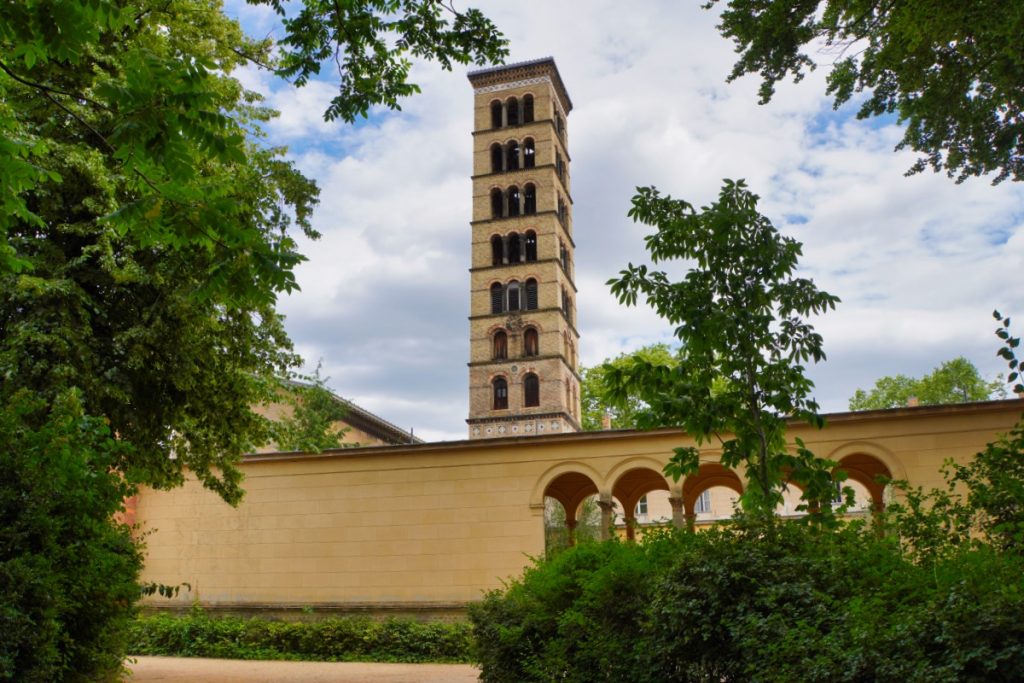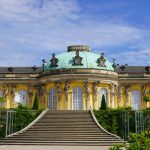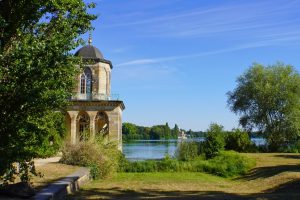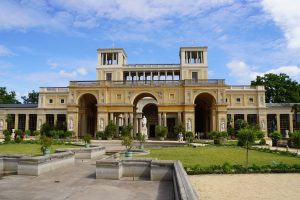If you enter Sanssouci’s Schosspark from the Green Gate, the main entrance, you can’t miss the Friedenskirche (Peace Church) in the Marly Garden. It is worth planning a visit, the church is exceptional.

Potsdam Friedenskirche – this is how it began
Crown Prince Friedrich Wilhelm IV made a sketch in 1839 that showed the first basic ideas of the Friedenskirche. Apparently he had seen the Church of San Clemente in Rome before, because his design showed some parallels to that building, but also had his own ideas, which were later incorporated into the exact building plans. A few years earlier, he had acquired a mosaic in Murano. It shows Jesus Christ sitting on the throne as the judge of the world. This mosaic was to find its new place in the apse of the Friedenskirche.
In 1840, Friedrich Wilhelm ascended the throne and his church plans could be implemented. The court architect Ludwig Persius had to change his plans several times, and only after two years of planning did the king approve the designs. Shortly after the laying of the foundation stone, the architect died and Friedrich August Stüler continued the construction according to his plans.

In September 1848, the church was consecrated in the presence of the royal couple. The free-standing bell tower was completed in 1850. The numerous ancillary structures, such as the Green Lattice, also took some time to complete. Finally, in 1890, the mausoleum for Emperor Friedrich III was added to the atrium.
Tour around the Friedenskirche
As you approach the church, the impressive 42-metre-high freestanding bell tower catches your eye.

It stands on the south side of the Friedenskirche. The tower is divided into seven open upper storeys. The bronze bells hang on the third floor above the clockwork. I have read that the bells have names: Gratia, Clementia, Pax and Gloria. Gloria is the largest bell and weighs about 870 kilograms.
If you go into the church, you will discover a beautiful coffered ceiling. The fields are blue and decorated with golden stars. The apse is decorated with a beautiful mosaic. It is almost in its original state and dates back to the 13th century. The four dark green columns of the altar superstructure are also very special. They date from 1842 and are a gift from the Russian Tsar Nicholas I.

Behind the right aisle is the former baptistery. The baptismal font has been moved into the nave. Behind the left aisle is the sacristy. After the death of Friedrich Wilhelm IV, it was first used as a mausoleum. Later, members of the Hohenzollern family and other members of the royal family were buried here. Only a few steps away from the church is the Emperor Friedrich Mausoleum, which unfortunately cannot be visited.
In the chancel, two large marble slabs set in front of the steps stand out. Under these slabs is the royal tomb.
I particularly like the beautiful courtyard with the statue of Christ. Today there is only a replica here. The original by Bertel Thorwaldsen can be seen in Copenhagen’s Church of Our Lady. The figure stands on a fountain, on the edge of which is a saying that translates as “Cleanse yourself of sins and not only your face”.

The Heilsbronn portal leading to the cloister is impressive. The entrance is modelled on a Romanesque stepped portal that can be seen in Heilsbronn Abbey. It was moulded in plaster and then fired from clay in Berlin. At first it stood in the clay manufacturer’s garden, as the king did not buy the gate. It was only when the descendants of the factory owner gave the portal away after his death that it was installed at its present location.

Address:
Friedenskirche Potsdam
Am Grünen Gitter 3
14469 Potsdam
Opening hours
Monday – Saturday: 11-17 h
Sunday: 12-17 h
Admission fee:
free
















Leave a Reply